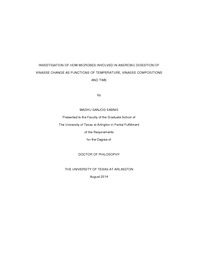| dc.description.abstract | Recent fossil fuel supply crunches and price spikes have prompted increased interest in ethanol as an alternative transportation fuel. However, vinasse, the liquid residue left from the distillation of ethanol, poses serious disposal challenges due to its high acidity, chemical oxygen demand, and concentrations of solids, nitrogen, phosphorous, and potassium. On average, 12-14 liters of vinasse are produced per liter of ethanol. Brazilian production of ethanol is estimated as 15.1 billion liters per year, meaning that the vinasse treatment and disposal problem for Brazil is particularly significant.Degradation via anaerobic microbes has been demonstrated as a viable option for vinasse treatment, which also produces renewable energy in the form of methane as a byproduct. Methane and other gases, produced in the anaerobic digestion of vinasse, are enough to generate 3.6 to 10.60 megawatts of electricity when vinasse BOD ranges from 1.06 to 3.12 lb/cu ft.The objective of this research was to investigate the microbes involved in the various stages of anaerobic degradation of vinasse, and how the numbers and species of microbes varied as functions of time, vinasse composition, and reactor temperature. This information will be useful for future seeding of industrial-scale vinasse treatment processes with appropriate microbes.Vinasse from production of ethanol from corn and milo was obtained from two U.S. companies; additional synthetic vinasse with various concentrations of parameters (COD, N, P, K, S) was prepared in the laboratory. Vinasse was placed in 6.8L glass bioreactors seeded with 10% sewage sludge obtained from an anaerobic process at a wastewater treatment plant. The reactors were operated at three mesophilic temperatures (30, 35 & 40˚C) in batch mode for 15-89 days, depending on methane production. Three molecular techniques, DNA extraction PCR, and Miseq, were used to determine microbial communities in each reactor as a function of time. Post-sequencing microbial community analysis was performed using QIIME software. As temperature increased, the run time generally decreased, as expected. Overall, the synthetic vinasse combinations had higher percentages of Archaea in the runs compared to real vinasse compositions. The synthetic vinasse thus produced higher levels of methane compared to the real vinasse combinations. The synthetic and real vinasse combinations at 30, 35, and 40°C contain higher percentages of Bacteroidetes, Firmicutes, and Proteobacteria and lower percentages of Archaea, Acidobacteria, Tenericutes, Spirochaetes, Synergistetes, Chloroflexi, Lentisphaerae, WWE1, Verrucomicrobia, Tenericutes, Spirochaetes, Synergistetes, and Plantomycetes. There were no overall trends of microbial phyla observed with time. | en_US |


